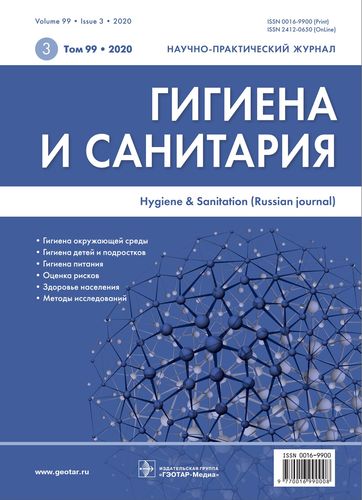Long-term dynamics of changes of anthropometrical indices of school students
- 作者: Pavlovskaja V.S.1, Kalishev M.G.2, Rogova S.I.2
-
隶属关系:
- Surgut State University
- Karaganda State Medical University
- 期: 卷 99, 编号 3 (2020)
- 页面: 286-290
- 栏目: HYGIENE OF CHILDREN AND ADOLESCENTS
- ##submission.datePublished##: 20.04.2020
- URL: https://vestnik.nvsu.ru/0016-9900/article/view/639853
- DOI: https://doi.org/10.47470/0016-9900-2020-99-3-286-290
- ID: 639853
如何引用文章
全文:
详细
Introduction. The relevant direction of studying the physical development of children and adolescents is the study of the dynamics of changes anthropometric indices from generation to generation. Systematic monitoring of regular indices in different regions is necessary.
Material and methods. A one-step study of anthropometric indices of 2990 healthy boys of East Kazakhstan aged from 6 to 17 years was carried out in 2016. Children were clustered into age groups and ethnicity according to the principles of anthropology. The research of anthropometric indices was performed according to generally accepted methods in the morning. The chest circumference was measured during the pause period.
The values of anthropometric indices of schoolchildren in 2016 were compared with the values of similar indices of children in 1986. Microsoft Office Excel 2007 was used to statistically process the data.
Results. In modern boys of the Kazakh nationality there is a harmonization of growth and weight indices. The maximum weight gain and chest circumference increase occurs at the same time as the “growth jump,” while 1986 schoolchildren had an average annual body weight gain one year late after the start of the rapid growth period. In Russian boys born in 1986 the maximum weight gain is established at 14 years, and in modern children - at the age of 13 years.
Conclusions. A comparative analysis of the multi-year dynamics of children’s anthropometric indices revealed acceleration trends reliably confirmed by the higher values of these indices in modern boys compared to their 1986 peers.There have been established national characteristics in the physical development of boys.
作者简介
Viktorija Pavlovskaja
Surgut State University
编辑信件的主要联系方式.
Email: wpav@list.ru
ORCID iD: 0000-0002-9204-8989
MD, Ph.D., associate professor, head of the department of physiology of medical institute of the Surgut State University.
e-mail: wpav@list.ru
俄罗斯联邦M. Kalishev
Karaganda State Medical University
Email: noemail@neicon.ru
ORCID iD: 0000-0002-6693-8646
俄罗斯联邦
S. Rogova
Karaganda State Medical University
Email: noemail@neicon.ru
ORCID iD: 0000-0002-5239-2566
俄罗斯联邦
参考
- Baranov A.A., Yampol’skaya YU.A. Features of physical development of teenagers [Osobennosti vneshnego razvitiya podrostkov. Fiziologiya rosta i razvitiya detey i podrostkov (teoreticheskiye i prakticheskiye voprosy)]. Moscow: GEOTAR-Media; 2006. 159 p. (in Russian)
- Bashirova G.I., Maliyevskiy V.A., Maliyevskiy O.A. Characteristics of physical development of children aged 5–7 living in a large industrial city. Meditsinskiy vestnik Bashkortostana. 2013; 8 (3): 5–10. (in Russian)
- Bobrishcheva-Pushkina N.D., Kuznetsova L.YU., Silayev A.A., Popova O.L. Physical and mental development of children and adolescents as an indicator of health status. Praktika pediatra. 2008; 3: 34–8. (in Russian)
- Bogomolova E.A., Kushnir S.M. State of adaptation and regulatory mechanisms in children of puberty. Voprosy sovremennoy pediatrii. 2006; 5 (1): 66. (in Russian)
- Kuchma V.R., Skoblina N.A., Milushkina O.Yu., Bokareva N.A. Comparative analysis of physical and biological development of schoolchildren in Moscow. Gigiena i sanitariya [Hygiene and Sanitation, Russian journal]. 2012; 4: 47–52. (in Russian)
- Mazur L.I., Shcherbitskaya O.V. Health status of teenagers in the Samara region. In: Proceedings of the XVI Congress of Pediatricians of Russia “Actual problems of pediatrics”. Moscow, February 15–18, 2010 [Sbornik materialov XVI kongressa pediatrov Rossii «Aktual’nyye problemy pediatrii». Moskva, 15–18 fevralya 2010 g.]. Moscow; 2010: 508. (in Russian)
- Mukatayeva ZH.M., Kabiyeva S.ZH. Monitoring of physical development and health of schoolchildren of the Pavlodar region. Vestnik Novosibirskogo gosudarstvennogo pedagogicheskogo universiteta. 2014; 1: 51–73. (in Russian)
- Filina T.P., Shvetsov A.G., Pavlovskaya V.S. Standards and evaluation tables of physical development of schoolchildren in East Kazakhstan. Instructional and methodical letter [Standarty i otsenochnyye tablitsy vneshnego razvitiya shkol’nikov Vostochnogo Kazakhstana. Instruktivno-metodicheskoye pis’mo]. Karaganda; 1986. 62 p. (in Russian)
- Feigelman S. Middle childhood. In: Kliegman R.M., Behrman R.E., Jenson H.B., Stanton B..F, eds. Nelson Textbook of Pediatrics. 19th ed. Philadelphia, Pa: Saunders Elsevier; 2011: chapter 11.
- Kalishev M.G., Rogova S.I., Macuk E.V. et al. Physical development of school-age children in Central Kazakhstan. In: Proceedings of the republican scientific-practical conference with international participation “Problems of diagnosis and correction of environmental-dependent disorders and occupational pathology [Materialy respublikanskoy nauchno-prakticheskoy konferentsii s mezhdunarodnym uchastiyem «Problemy diagnostiki i korrektsii ekologo-zavisimykh narusheniy i professional’noy patologii»]. Karaganda; 2015: 346–8. (in Russian)
补充文件







